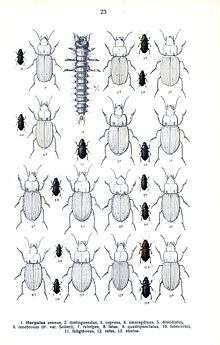Harpalus laevipes
Harpalus laevipes is a species of black coloured phytophagous ground beetle in the Harpalinae subfamily that is absent in the following European and African countries and islands: Andorra, Azores, Balearic Islands, Canary Islands, the Channel Islands, Corsica, Crete, Cyclades Cyprus, Dodecanese, Faroe Islands, Franz Josef Land, Gibraltar, Greece, Iceland, Madeira, Malta, Moldova Monaco, North Aegean islands, Novaya Zemlya, Portugal, San Marino, Sardinia, Selvagens Islands, Sicily, Svalbard and Jan Mayen, and Vatican City. It is also found in such Asian countries as Georgia, Japan, Kazakhstan, Turkey and Chinese provinces of Shanxi and Xinjiang.[1] It is also common in Canada and the United States.[2]
| Harpalus laevipes | |
|---|---|
 | |
| Scientific classification | |
| Kingdom: | Animalia |
| Phylum: | Arthropoda |
| Class: | Insecta |
| Order: | Coleoptera |
| Family: | Carabidae |
| Genus: | Harpalus |
| Species: | H. laevipes |
| Binomial name | |
| Harpalus laevipes Zetterstedt, 1828 | |
| Synonyms[1] | |
| |
Description
The species is 9.5–12 millimetres (0.37–0.47 in) long.[3]
Distribution
In Ireland, the species is found in Little Sugar Loaf and Black Head in the Burren, Clare. In Russia, it is found in Siberia and the Caucasus.[3]
Habitat and ecology
It is found in gravelly moraines and shallow soils. It can also be found under stones, low herbal shrubs and limestone. The species is quite equipped to the mountainous lifestyle. It feeds on Calluna species.[3]
References
- "Harpalus (Harpalus) laevipes Zetterstedt, 1828". Carabidae of the World. December 29, 2011. Retrieved February 21, 2013.
- "Canadian distribution". 1.0. Coleoptera of The World. 2011. Archived from the original on April 16, 2013. Retrieved February 21, 2013.
- "Harpalus laevipes". National Museums Northern Ireland. Retrieved February 21, 2013.